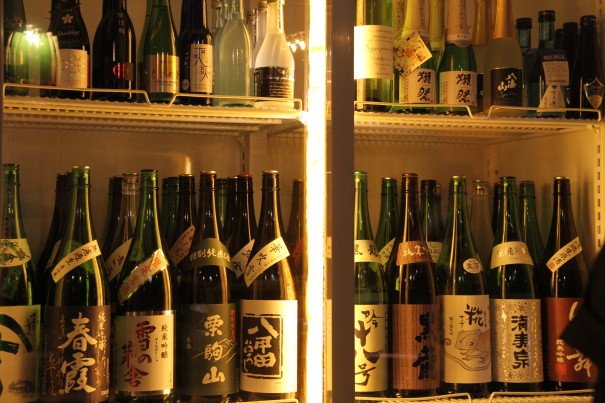
Decoding Sake in a Dank Osaka Basement

Decoding Sake in a Dank Osaka Basement
Shimada Shoten in Osaka. Post sponsored by Umeda Area Management Alliance
For first-timers and seasoned boozers alike, understanding the nuances and nomenclature of Japanese sake can be a daunting task. Ginjo or daiginjo? Hot or cold? Filtered or not? Aged like a big French red or fresh like a spring shower? When presented with a kanji-riddled menu of rice wine selections, most gaijin punt and opt for a biru instead.
In a dank basement on a quiet street in Osaka’s Minamihorie neighborhood, sake neophytes can get a liquid education. Shimada Shoten is primarily a sake distributor, with a storefront stocked with a selection of Japan’s finest nihonshu (the owners tell me they have personally visited over 250 breweries to build out their list), but drop down a secret staircase and you land in the tasting room, with transport barrels and half-drunk bottles scattered everywhere. I descend into the basement with a local friend in tow, the two of us prepared for one of the meandering food-and-booze crawls that make Osaka Disneyland for serious eaters. A group of men who look like they haven’t seen daylight all week herald our arrival with a chorus of grunts.
Shimada operates on the honor system. Choose your glass from a stable of beautiful ceramic sake vessels, pick your poison from a series of refrigerators, and at the end of the night, tally up all the damage. Let’s go.
We warm up with a sparkling sake from Hiroshima, then move on to a junmai daiginjo from Ishikawa prefecture, one of Japan’s best sake-producing regions. You can taste its greatness, a cool shower of stone fruit and spring flowers. One refrigerator houses koshu, aged sake, and we take our chances with a 12-year bottle from Kyoto. Aged sake makes up only a fraction of a percent of Japan’s total sake production, and remains a controversial beverage, given the vast range of quality found in the end product. This particular koshu is as dark and musty as the room we’re drinking it in.
We need a landing pad for all this rice wine, so we order the only food they serve in this joint: chunky miso from Wakayama, purple piles of pickled plums, and a strangely delicious cream cheese spiked with sake that pairs perfectly with nearly everything we pour.
Nihonshu sneaks up on you. It goes down gently, floral and cold, coating your throat in the most positively medicinal of ways. There is no recoil, no heartburn, no palpable reminder that what you’re drinking is an intoxicant—just gentle sweetness and the earthy whisper of fermentation. The beauty and size of most sake glasses—scarcely larger than a shot glass—adds to the apparent innocence of it all. But once you get started on a proper sake session, with you pouring for your partners and your partners pouring for you and nobody allowing a glass to ever approach empty, it takes on a momentum of its own.
Sake is produced in all but one of Japan’s 47 prefectures (Kagoshima reserves its distilling ambitions for potato shochu), and the early evening unspools into a liquid road trip. Nagano, Akita, Nara, Sendai, Okayama: We race our way around Japan, testing the harvest from every corner of the country, probing the borders with our tiny glasses, savoring the nuances of climate and topography: the snow melt from the mountains above Niigata, the pristine waters that flow from the Katsura River outside of Nara, the long, sunny days of Okinawa. A proper sake tasting will whisk you around Japan faster than the Shinkansen.
You could lose yourself quickly down the Shimada rabbit hole, which is probably why it closes at 7 pm sharp. The night has just begun—five or six hours of binge eating, drinking, and bonhomie await us above the basement—and a few stops later, I’ll forget most of what I’ve come to understand over the past hour of drinking. But for a few glorious blocks strolling the city’s low-lit streets, the world of sake all makes perfect sense.